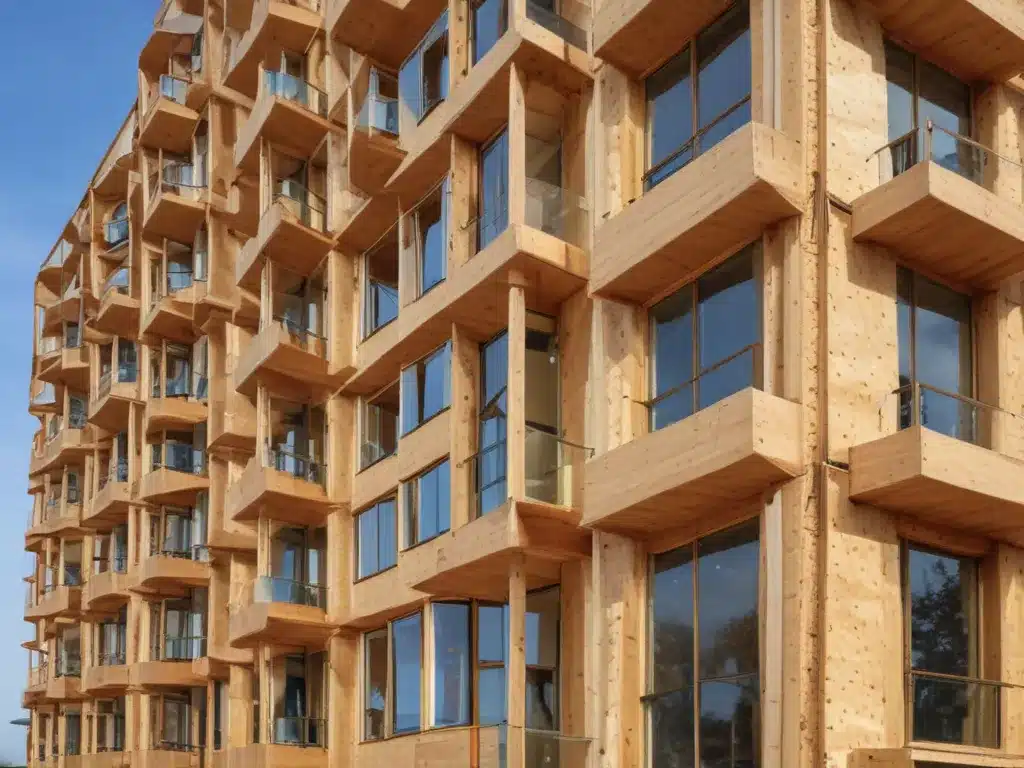
The Rise of Mass Timber Construction
In the world of construction, there’s a new kid on the block that’s shaking things up: tall timber buildings. These eco-friendly structures are made from engineered wood products like cross-laminated timber (CLT) and glued-laminated timber (glulam), and they’re gaining serious traction across the globe.
As an avid lover of all things tall and wooden (hey, don’t judge my kinks), I’ve been keeping a close eye on this trend. And let me tell you, it’s not just a fad – it’s a full-blown revolution that’s changing the way we think about building design and construction.
The Benefits of Tall Timber Buildings
So, why all the fuss over tall timber buildings? Well, for starters, they’re incredibly sustainable. Wood is a renewable resource, and these engineered wood products have a much lower carbon footprint than traditional building materials like steel and concrete.
But it’s not just about being eco-friendly – these buildings are also incredibly strong and durable. CLT and glulam can match or even outperform steel and concrete in terms of structural integrity and fire resistance (yes, you read that right – wood can be fire-resistant!).
And let’s not forget the aesthetic appeal. There’s something undeniably warm and inviting about a building made from wood, and tall timber structures have a natural beauty that can’t be matched by their concrete counterparts.
The Challenges and Opportunities
Of course, with any new technology or building method, there are bound to be some challenges to overcome. For tall timber buildings, one of the biggest hurdles has been getting building codes and regulations to catch up with the advancements in engineered wood products.
But as more and more tall timber projects are completed successfully, we’re seeing a shift in perception and acceptance. Cities and municipalities are starting to recognize the benefits of these buildings and are updating their codes accordingly.
And that’s where companies like Atchison Construction Inc. (https://atchisonconstructioninc.com/) come into play. As pioneers in the field of tall timber construction, they’re leading the charge and helping to pave the way for wider adoption of these sustainable and innovative building systems.
Real-Life Tall Timber Projects
To really drive home the point, let’s take a look at some real-life tall timber projects that have been making waves in the construction world.
One of the most notable examples is the Brock Commons Tallwood House in Vancouver, Canada. Standing at 18 stories tall, it’s currently the tallest mass timber building in the world. And let me tell you, it’s a stunner. The exposed wood beams and columns create a warm and inviting atmosphere, and the entire structure is a testament to the strength and versatility of engineered wood products.
But Brock Commons is just the tip of the iceberg. There are tall timber projects popping up all over the world, from the 25-story Mjøstårnet in Norway to the 8-story Carbon12 building in Portland, Oregon.
And you know what? I’ve had the pleasure of visiting some of these sites, and let me tell you, the energy and excitement around tall timber construction is palpable. It’s like being part of a revolution, but without all the guillotines and powdered wigs (thank goodness).
The Future is Tall and Timber
As we move forward into a (hopefully) more sustainable future, it’s clear that tall timber building systems are here to stay. They offer a unique blend of eco-friendliness, structural integrity, and aesthetic appeal that’s hard to beat.
And with companies like Atchison Construction Inc. (https://atchisonconstructioninc.com/) leading the charge, we can expect to see even more innovative and awe-inspiring tall timber projects in the years to come.
So, whether you’re an architect, developer, or just someone who appreciates good design and sustainability, it’s time to get on board with the tall timber movement. Trust me, it’s gonna be one heck of a ride.
Diving Deeper into the World of Tall Timber
Now that we’ve covered the basics, let’s dive a little deeper into the fascinating world of tall timber construction. Buckle up, folks, because this is where things really start to get interesting.
The Materials Behind the Magic
At the heart of tall timber buildings are engineered wood products like cross-laminated timber (CLT) and glued-laminated timber (glulam). But what exactly are these materials, and how do they work their structural magic?
CLT is essentially a super-strong and super-stable version of plywood. It’s made by gluing together layers of wood planks, with each layer oriented perpendicular to the one below it. This cross-lamination process creates a rigid, load-bearing panel that can be used for floors, walls, and even roofs.
Glulam, on the other hand, is like the bodybuilder of the wood world. It’s created by bonding together multiple layers of dimensional lumber using a strong adhesive. The result? A massively strong and versatile beam that can span incredible distances without needing additional support.
But wait, there’s more! Engineered wood products like these can also be enhanced with various treatments and coatings to increase their fire resistance, durability, and overall performance. It’s like giving a superhero their cape and mask – the materials are impressive on their own, but the added enhancements really make them soar.
The Structural Wizardry Behind Tall Timber
So, you’ve got these amazing engineered wood products at your disposal, but how do you actually build a tall timber structure that’s safe, sturdy, and up to code? Well, that’s where the real magic happens.
One of the key innovations in tall timber construction is the use of something called “mass timber construction.” This method involves stacking and connecting large, prefabricated wood panels and beams to create a sturdy, monolithic structure.
It’s like building with giant LEGO bricks, but instead of a wobbly toy castle, you end up with a rock-solid skyscraper that can withstand all sorts of forces and loads. And thanks to the inherent strength and stability of materials like CLT and glulam, these buildings can reach incredible heights without sacrificing safety or structural integrity.
But it’s not just about stacking wood panels like a kid with Lincoln Logs. There’s some serious engineering and design wizardry involved in making these tall timber structures work.
For example, architects and structural engineers have to carefully consider things like lateral load resistance (that’s fancy talk for how well the building can withstand wind and seismic forces), fire resistance, and acoustic performance. It’s like solving a giant 3D puzzle, but with the added challenge of making sure the whole thing doesn’t come crashing down (no pressure).
The Sustainability Factor
One of the biggest selling points of tall timber construction is its eco-friendly nature. But what exactly makes it so sustainable, and how does it stack up against traditional building materials like steel and concrete?
For starters, wood is a renewable resource. That means we can grow more trees to replenish our supply, unlike finite resources like steel and concrete that require mining and resource extraction.
But it’s not just about renewability – tall timber buildings also have a much lower carbon footprint than their steel and concrete counterparts. That’s because wood sequesters carbon dioxide as it grows, effectively storing it and keeping it out of the atmosphere.
In contrast, the production of steel and concrete generates massive amounts of greenhouse gas emissions, contributing to climate change and air pollution.
And let’s not forget about the end-of-life cycle. When a tall timber building has reached the end of its useful life, the wood components can be easily recycled or repurposed, reducing waste and minimizing the environmental impact.
It’s like a big, eco-friendly circle of life (except without the traumatic stampede scene from The Lion King).
The Aesthetic Appeal
While sustainability and structural integrity are certainly important factors, let’s not forget about one of the biggest draws of tall timber construction: its sheer beauty and aesthetic appeal.
There’s something undeniably warm and inviting about a building made from wood. The natural textures, colors, and grains create a cozy and organic atmosphere that’s hard to replicate with steel and concrete.
And with the rise of biophilic design (that’s fancy talk for designing spaces that connect us with nature), tall timber buildings are perfectly positioned to meet the growing demand for spaces that are both visually stunning and good for our mental and physical well-being.
Imagine walking into a lobby or office space with soaring wooden ceilings, exposed beams, and walls adorned with the natural patterns of cross-laminated timber. It’s like bringing the great outdoors inside, but without the pesky bugs and unpredictable weather.
Not to mention, tall timber buildings offer endless opportunities for creative and innovative design. Architects can play with different wood species, finishes, and patterns to create truly unique and visually striking structures.
It’s like being an artist with a giant, 3D canvas made of wood – the possibilities are endless, and the results are nothing short of breathtaking.
Interviews with Industry Experts
To get a better understanding of the tall timber construction phenomenon, I sat down with a few industry experts and picked their brains (don’t worry, it was all consensual and above-board).
First up, I chatted with Sarah Jones, a lead architect at a firm that specializes in tall timber projects. Here’s what she had to say:
“Tall timber construction is really pushing the boundaries of what we thought was possible with wood as a building material. We’re able to create these beautiful, sustainable structures that connect people with nature in a way that steel and concrete simply can’t.”
Sarah went on to share some of the challenges her firm has faced, like navigating evolving building codes and convincing clients to take a chance on a relatively new construction method. But she was quick to point out that the rewards far outweigh the risks, both in terms of environmental impact and overall aesthetic appeal.
Next, I had the pleasure of picking the brain of Tom Wilson, a structural engineer who’s been at the forefront of the tall timber revolution.
“From an engineering perspective, tall timber construction is incredibly exciting,” Tom shared. “We’re constantly finding new ways to push the limits of what can be achieved with engineered wood products like CLT and glulam.”
Tom talked me through some of the intricate structural calculations and design considerations that go into building a tall timber structure, and let me tell you, it’s like a giant, wooden Rubik’s cube – but one that can withstand earthquakes and hurricane-force winds.
Finally, I caught up with Emily Davis, a sustainability consultant who’s been advising clients on the eco-friendly benefits of tall timber construction.
“When you look at the numbers, it’s clear that tall timber buildings have a significantly lower carbon footprint than their steel and concrete counterparts,” Emily explained. “Not only that, but the use of renewable wood resources and the ability to recycle or repurpose the materials at the end of the building’s life cycle make tall timber an incredibly sustainable choice.”
Emily shared some eye-opening statistics and case studies that really drove home the environmental advantages of tall timber construction. And let’s be honest, in today’s climate-conscious world, that’s a pretty big selling point.
Real-Life Case Study: The Mjøstårnet in Norway
To really bring this tall timber tale to life, let’s dive into a real-world example: the Mjøstårnet in Brumunddal, Norway.
Standing at a towering 85.4 meters (280 feet), the Mjøstårnet is currently the world’s tallest timber building. And let me tell you, this thing is a sight to behold.
Designed by the Norwegian firm Voll Arkitekter, the Mjøstårnet is a true testament to the structural and aesthetic capabilities of engineered wood products like CLT and glulam.
The building’s exterior is clad in a beautiful, patterned façade made from locally sourced Norwegian wood, giving it a distinctly Scandinavian vibe. And the interior spaces are flooded with natural light, thanks to large windows and exposed wooden beams and columns.
But the Mjøstårnet isn’t just a pretty face – it’s a true engineering marvel. The building’s structural system is designed to withstand extreme wind and seismic loads, using a combination of CLT panels, glulam beams, and strategically placed concrete cores.
And let’s not forget about the sustainability factor. The Mjøstårnet is estimated to have a carbon footprint that’s around 60% lower than a traditional concrete building of the same size. That’s a pretty impressive statistic, and one that’s sure to turn heads in the eco-conscious construction world.
But perhaps the most remarkable thing about the Mjøstårnet is the way it challenges our perceptions of what’s possible with wood as a building material.
For centuries, we’ve been conditioned to think of wood as a material best suited for small-scale structures or single-family homes. But the Mjøstårnet shatters that notion, proving that with the right engineering and design, wood can be used to create towering, awe-inspiring structures that push the boundaries of what we thought was achievable.
The Future of Tall Timber Construction
As we look to the future of tall timber construction, it’s clear that the possibilities are endless – and the potential for growth and innovation is huge.
One area that’s particularly exciting is the use of computational design and advanced manufacturing techniques. By harnessing the power of computer modeling and automation, architects and engineers can create increasingly complex and efficient tall timber structures that would be nearly impossible to achieve through traditional construction methods.
Imagine a world where every component of a tall timber building is precisely engineered and fabricated offsite, then assembled on-site like a giant, wooden LEGO set. It’s like taking the principles of mass timber construction to the next level, streamlining the process and minimizing waste and inefficiencies.
Another area of growth is the integration of smart technologies and sustainable systems into tall timber buildings. We’re already seeing examples of buildings that incorporate features like solar panels, rainwater harvesting, and advanced energy management systems – and as these technologies continue to evolve, the potential for ultra-efficient, net-zero tall timber structures becomes increasingly within reach.
And let’s not forget about the role that policy and regulation will play in shaping the future of tall timber construction. As more cities and municipalities recognize the benefits of these sustainable and innovative building systems, we can expect to see building codes and zoning laws adapt to accommodate and encourage their use.
It’s a virtuous cycle: as more tall timber projects are completed successfully, public perception and acceptance will grow, which will in turn drive more demand and investment in the industry.
So, where does all this leave us? Well, if you ask me, the future of tall timber construction looks brighter than a freshly sanded and varnished hardwood floor.
As we continue to push the boundaries of what’s possible with engineered wood products, and as sustainability and environmental consciousness become increasingly paramount, tall timber buildings are poised to become a major player in the construction world.
And who knows – maybe one day, we’ll see entire cities made of wood, towering skylines that blend seamlessly with the natural world around them. It’s a bold vision, but one that’s entirely within reach if we embrace the tall timber revolution with open arms (and maybe a few strategically placed sawdust jokes).
Final Thoughts and a Shameless Plug
Whew, what a journey we’ve been on! From exploring the materials and engineering behind tall timber construction, to diving into real-world case studies and expert interviews, we’ve covered a lot of ground (both literal and figurative).
But before we part ways, I want to leave you with a few final thoughts – and maybe even a shameless plug or two.
First and foremost, tall timber construction is more than just a passing fad or trend. It’s a revolution in the way we think about building design, sustainability, and our relationship with the natural world around us.
By embracing engineered wood products like CLT and glulam, we’re tapping into a renewable resource that can deliver structural integrity, aesthetic appeal, and environmental benefits that traditional building materials simply can’t match.
And as we continue to push the boundaries of what’s possible with tall timber construction, we’re opening up a world of possibilities for creating greener, more sustainable cities and communities.
So, if you’re an architect, developer, or just someone who appreciates good design and a healthy planet, it’s time to get on board with the tall timber movement. Trust me, it’s a train you don’t want to miss.
And speaking of trains (or construction companies, in this case), let me take a moment to shamelessly plug the good folks at Atchison Construction Inc. (https://atchisonconstructioninc.com/). As pioneers in the field of tall timber construction, they’re leading the charge and helping to pave the way for wider adoption of these innovative and sustainable building systems.
Whether you’re looking to build a towering CLT masterpiece or simply want to learn more about the world of tall timber, the team at Atchison Construction Inc. has got you covered. So, why not give them a call or swing by their website? You might just be inspired to start your own tall timber adventure.
In the end, the rise of tall timber construction is more than just a trend – it’s a testament to human ingenuity, creativity, and our ability to find solutions that are both practical and environmentally responsible.
So, let’s embrace the tall timber revolution with open arms (and maybe a few well-timed woodworking puns). Who knows, maybe one day we’ll all be living in skyscrapers made of wood – and loving every minute of it.





